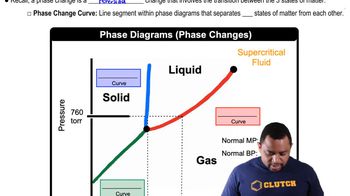Here are the essential concepts you must grasp in order to answer the question correctly.
Phase Transitions
Phase transitions refer to the changes in the state of matter, such as from solid to liquid (melting), liquid to gas (vaporization), and vice versa. These transitions occur at specific temperatures and pressures, and they involve energy changes, typically in the form of heat. Understanding these transitions is crucial for analyzing physical processes and the behavior of substances under varying conditions.
Recommended video:
Phase Changes in Diagrams
Thermodynamics
Thermodynamics is the branch of physics that deals with heat, work, and energy transformations. It provides the principles governing phase transitions, including the concepts of enthalpy and entropy. By applying thermodynamic principles, one can predict how a substance will behave during a phase change, including the energy required for the transition and the conditions under which it occurs.
Recommended video:
First Law of Thermodynamics
Phase Diagrams
Phase diagrams are graphical representations that show the phases of a substance at various temperatures and pressures. They illustrate the conditions under which different phases coexist and the boundaries between them, known as phase boundaries. Analyzing phase diagrams helps in understanding the specific phase transitions a substance undergoes, as well as the critical points where these transitions occur.
Recommended video:
Phase Changes in Diagrams



